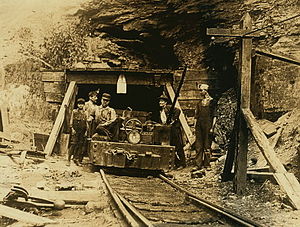- Drift mining
-
Drift mining is either the mining of a placer deposit by underground methods, or the working of coal seams accessed by adits driven into the surface outcrop of the coal bed. Drift is a more general mining term, meaning a near-horizontal passageway in a mine, following the bed (of coal, for instance) or vein of ore. A drift may or may not intersect the ground surface.[1] This kind of mining is done when the rock or mineral is on the side of a hill.
Contents
Nome, Alaska
Drift mining methods were used extensively to mine placer deposits during the early years of the Nome mining district. During summer, surface deposits could be worked, but some placer deposits were buried too deeply for surface placering. In addition, water to wash the gold from the placers was not available in the winter. Many miners tunnelled into deep placer deposits, bringing out the high-grade gravels to be washed at the spring thaw. Most of the ground in Nome is permafrost. By drift mining, miners were able to recover much of the gold buried under the permafrost.
Gold at Nome was concentrated in three ancient beach lines, now inshore, above sea level, and buried under roughly fifty feet of permafrost overlain by two feet of tundra. Gold was usually found on top of either bedrock or "false bedrock," a layer of clay that occurred at the base of the beach or stream deposit.
The miners initially sank shafts to prospect for the pay streaks. This was done by building a fire atop the permafrost, and, each day as it melted, shovelling away the mud. The process would be continued down to either a pay streak or bedrock. When the gold was found, the drift mining began.
Once they had found a pay streak, miners would tunnel horizontally from the bottom of their prospect shaft, and follow the gold along the surface of the bedrock. The tunnels, because the ground was frozen, would not cave in. Miners discovered old underground beach and river gravels rich with gold. Around 1900 the population of Nome was more than twenty thousand, many of them drift miners. Nome's gold fields, appearing untouched from the surface, are honeycombed with tunnels left by the gold rush drift miners. Today's miners, prospecting with modern drilling equipment, sometimes hit old drifts.
See also
References
- ^ Paul W. Thrush, A Dictionary of Mining, Mineral, and Related Terms, US Bureau of Mines, 1968, p.350.
External links
Mining techniques Surface Sub-surface Categories:- Underground mining
- Mining stubs
Wikimedia Foundation. 2010.

